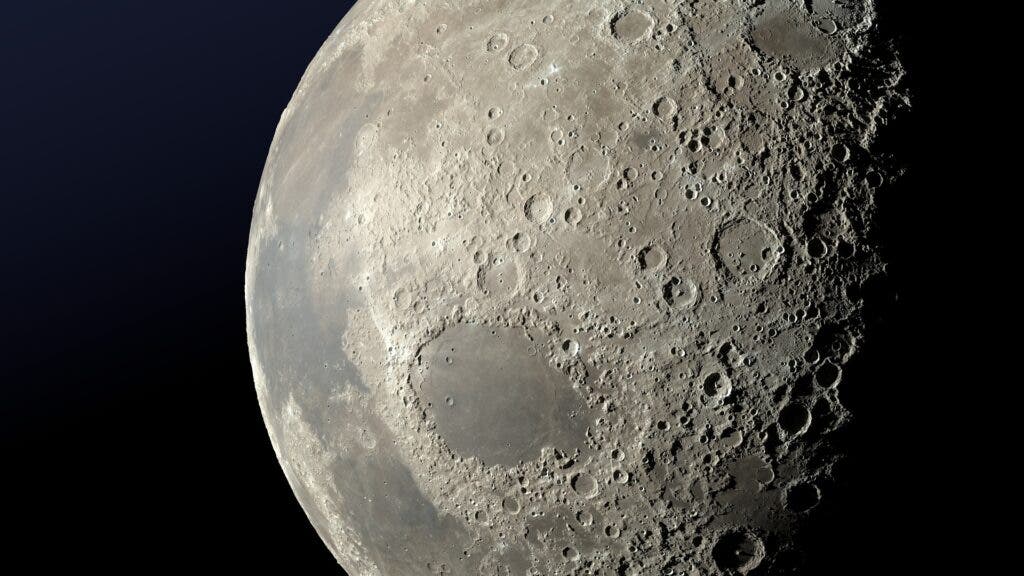The Moon’s violent past could hold the key to its future exploration. Thanks to a series of volcanic eruptions that took place 2-4 billion years ago and blanketed the satellite’s surface in hot lava, future moon dwellers might have access to drinkable water.
Over the eons that have passed since these eruptions, the lava created dark blotches (called maria) which have come to characterize the Moon’s surface. Now, a report by researchers at the University of Colorado, Boulder, notes that these eruptions might have also trapped sheets of ice — sheets that could be hundreds of feet thick.
“We envision it as a frost on the moon that built up over time,” said Andrew Wilcoski, lead author of the new study and a graduate student in the Department of Astrophysical and Planetary Sciences (APS) and the Laboratory for Atmospheric and Space Physics (LASP) at CU Boulder.
Published in The Planetary Science Journal, the study is based on computer simulations that try and recreate conditions on the Moon long before complex life emerged on Earth, forming stores of ice that may still be hiding in lunar craters. Had they been around at the time, humans may even have seen a sliver of that frost near the border between day and night on the Moon’s surface.
This finding is more than just a curiosity from the moon’s history — it’s a potential bounty for Moon explorers who will need water to live and carry out activities on the moon, both for both drinking and fuel.
A song of ice and fire
This study adds to a growing body of evidence that suggests the moon may have a lot more water than previously thought. According to a 2020 study from study co-author Paul Hayne, nearly 6,000 square miles of the moon’s surface could be capable of trapping and hanging onto the ice, mostly near the moon’s north and south poles.
“It’s possible that five or 10 meters below the surface, you have big sheets of ice,” said Paul Hayne, assistant professor in APS and LASP. “There are a lot of potential sources at the moment.”
The irony is that this cold ice may have been preserved by massive volcanic eruptions.
Billions of years ago, tens of thousands of volcanoes erupted on its surface, generating rivers and lakes of lava similar to those seen on Hawaii today, but at a much larger scale than what we normally see on Earth.
Researchers at the Lunar and Planetary Institute in Houston recently discovered that these volcanoes probably also emitted towering clouds of carbon monoxide and water vapor. These clouds then swirled around the moon, potentially creating thin and short-lived atmospheres. So could this same atmosphere have left the ice on the surface?
To find out, the duo set out with Margaret Landis, a research associate at LASP, to try and virtually put themselves on the lunar surface billions of years ago, through computer simulations. The team estimated that the Moon experienced an eruption every 22,000 years at its peak. The researchers then tracked how volcanic gases may have swirled around the Moon, escaping into space over time.
The team found that, yes, conditions could have gotten a bit frosty at the key moment. According to the group’s estimates, roughly 41% of the water from volcanoes may have condensed onto the moon as ice.
“The atmospheres escaped over about 1,000 years, so there was plenty of time for ice to form,” Wilcoski said.
There may have been so much ice on the moon, in fact, that one could conceivably have spotted the sheen of frost and thick, polar ice caps from Earth. The group calculated that 18 quadrillion pounds of volcanic water could have condensed into ice during that time — more water than currently sits in Lake Michigan.
The research indicates that much of that lunar water may still be present today, but finding it won’t be easy. Most of it most likely currently resides near the Moon’s poles and could be buried under several feet of lunar soil (regolith) and will require a lot of surveying and digging.










